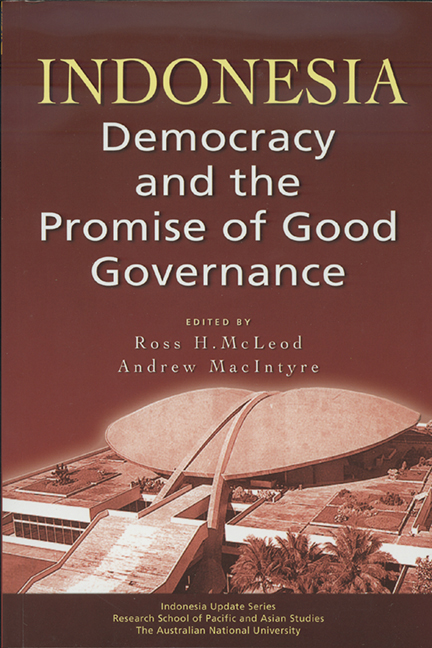Book contents
- Frontmatter
- Contents
- List of Tables and Figures
- List of Contributors
- Acknowledgments
- Glossary
- 1 Introduction
- PART I FORMING AND REFORMING THE ARCHITECTURE of GOVERNANCE
- 2 Indonesia's Constitutional Change Reviewed
- 3 Electoral and Political Party Reform
- 4 Tracing the Progress of Local Governments since Decentralisation
- PART II THE ROLES OF GOVERNMENT
- PART III THE INSTITUTIONS OF GOVERNMENT
- Index
- INDONESIA UPDATE SERIES
2 - Indonesia's Constitutional Change Reviewed
from PART I - FORMING AND REFORMING THE ARCHITECTURE of GOVERNANCE
Published online by Cambridge University Press: 21 October 2015
- Frontmatter
- Contents
- List of Tables and Figures
- List of Contributors
- Acknowledgments
- Glossary
- 1 Introduction
- PART I FORMING AND REFORMING THE ARCHITECTURE of GOVERNANCE
- 2 Indonesia's Constitutional Change Reviewed
- 3 Electoral and Political Party Reform
- 4 Tracing the Progress of Local Governments since Decentralisation
- PART II THE ROLES OF GOVERNMENT
- PART III THE INSTITUTIONS OF GOVERNMENT
- Index
- INDONESIA UPDATE SERIES
Summary
THE PROCESS OF CONSTITUTIONAL CHANGE
The constitution of any country defines both the institutions by which the country governs itself and the relationship between its citizens and its institutional framework. A constitution is a fundamentally political document, establishing the rights and duties of citizens and state institutions, and reflecting also the way in which society wishes to be governed. It may therefore be expected to be the result of wide-ranging political debate. As with any process of political debate, there will be some with interests to promote or protect. It is legitimate and indeed desirable that constitutional debate should centre on long-term vision. However, it is also inevitable that particular short-term, sectoral or even venal interests will affect the course of that debate, and that a constitution will be the product of its time and environment.
The story of the constitutional amendment process undertaken by Indonesia between 1999 and 2002, and the implementation of the amended constitution, exemplifies this. Although some may have believed that there was some kind of ideal constitution which could be devised or discovered by independent technical experts, in practice that was never going to be the case. Institutional history, narrow political interests and vision on the part of some of the key players were all significant in the progress that was made and the failures and setbacks that took place. It is now over two years since the 2004 general and presidential elections– the first to take place within the framework of the amended constitution. Sufficient time has therefore elapsed to attempt an assessment of the new institutions.
THE 1945 CONSTITUTION OF INDONESIA
In its original form, the 1945 Constitution of Indonesia contained only 37 articles. It was written as a temporary text. Its pattern of state institutions was substituted in practice within three months of its promulgation, and no other nation has since copied it. Yet the 1945 Constitution has enduring emotional significance for most Indonesians as a symbol of the struggle for independence and as a founding pillar of the unitary state of the Republic of Indonesia. In the transition after 1998, not only the substance but also the symbol of ‘the 1945 Constitution’ was at stake.
- Type
- Chapter
- Information
- IndonesiaDemocracy and the Promise of Good Governance, pp. 21 - 40Publisher: ISEAS–Yusof Ishak InstitutePrint publication year: 2007



